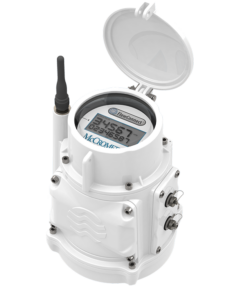McCrometer and its engineering team have built flow meters for over 60 years, refining and improving them along the way. From mechanical propeller meters to electromagnetic meters with signal outputs, McCrometer has products for a wide variety of uses and situations. As center-pivot irrigation becomes more technologically sophisticated and draws
on a wider range of data, flow meters are becoming an integral part of a center-pivot system. McCrometer’s flow meters can easily send data to a center-pivot control panel, providing a reliable measure of water flow on a continuous basis. In this interview, Ken Quandt, the government relations specialist for McCrometer, speaks with Irrigation Leader Managing Editor Joshua Dill about how flow meters can help any center-pivot irrigating farmer.

Joshua Dill: Please tell us about your background and how you came to be in your current position.
Ken Quandt: I live in Aurora, Nebraska, and have lived in Nebraska my whole life. I went to the University of Nebraska–Lincoln and got a degree in natural resources and water science. I also received a master’s degree in legal studies. After that, I went out to Sidney, Nebraska, and worked as the water programs manager for the South Platte Natural Resources District for 11 years. Then I moved to Aurora, where I started working for what was then Great Plains Meter, which was subsequently acquired by McCrometer. I worked as a regional sales manager for 6 or 7 years. Since then, I have been in a government relations position, working with conservation districts on their meter programs and developing grant proposals for special projects. In this position, I also work with McCrometer’s agricultural regional sales managers across the United States on regional meter programs.
Joshua Dill: Please tell us about McCrometer as a company.
Ken Quandt: McCrometer was founded in 1955 in Southern California, manufacturing flow meters for the agriculture industry. The water districts in California needed a durable, affordable meter to measure water for their customers, so a couple of brothers and a brother-in-law started manufacturing the McCrometer propeller meter. The design is basically the same today, although it has been continuously improved over the decades, meaning that we’ve been building the McCrometer propeller meter for agriculture for over 60 years. Over that time, however, McCrometer has also branched out into the oil and gas, municipal, and industrial markets, as well as developed other meter technologies. Today, McCrometer has 189 employees worldwide.
Joshua Dill: How can McCrometer meters be used with center pivots?
Ken Quandt: McCrometer has a line of telemetry-ready meters for the agricultural market. The way I look at it, that also means that the meters are pivot ready. They have built-in digital or analog signal outputs that can be entered into a farmer’s pivot panel. A digital signal is a pulse that’s normally used for totalization of flow; an analog signal, which can be a 4–20 milliamp (mA) signal, is used to monitor flow rate. Our technology is capable of transmitting a farmer’s irrigation flow data into the pivot panel, so that it can be used for irrigation water management.
Joshua Dill: Does that data give the farmer a better sense of how fast water is entering the system?

Ken Quandt: Yes. The output of the meter provides information that allows the farmer to record and monitor water application. That is important because a well’s flow rate can fluctuate over time, even within the season, for a number of reasons. These data assist the farmer in making changes to pivot speed or in setting times for precise application rates. If farmers assume a constant flow rate, they could be significantly under-irrigating their crops.
Joshua Dill: Is the information from the meter automatically incorporated into the data displayed in the center pivot’s control panel?
Ken Quandt: Yes. Most center pivots are capable of taking inputs from devices like flow meters, which have a pulse output that is used to monitor totalization. McCrometer has made the propeller meter for over 60 years, and most people think of it as a 100 percent mechanical device with no outputs. We do still manufacture meters like that, but for over a decade now McCrometer has also manufactured a propeller meter with a digital register, the FlowCom Register, which has signal output capabilities. It is becoming more popular, partly because of that signal output technology, which sends data to devices like center-pivot panels. It could also go to telemetry or into a data logger. Another advantage of the FlowCom Register over a mechanical register is that it has no moving parts and requires less maintenance. It’s a more streamlined device, without the traditional transmitters that are used with a mechanical register. It’s also battery powered, and when it is used in conjunction with a pivot panel, it can be externally powered, with the battery serving as a backup power source.
Joshua Dill: Are your meters compatible with most existing center- pivot technologies?
Ken Quandt: Yes. The signal outputs
I mentioned, the digital pulse or the 4–20 mA signal, are industry standard. They’re used with most devices like this in the industry.
Ken Quandt is the government relations specialist at McCrometer. He can be reached at kenq@mccrometer.com or (402)694-6443.
